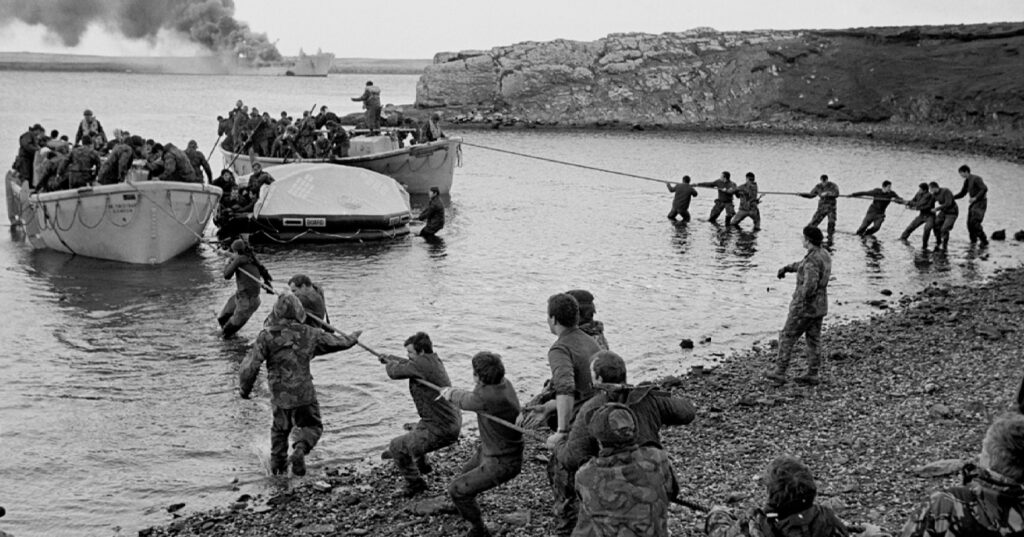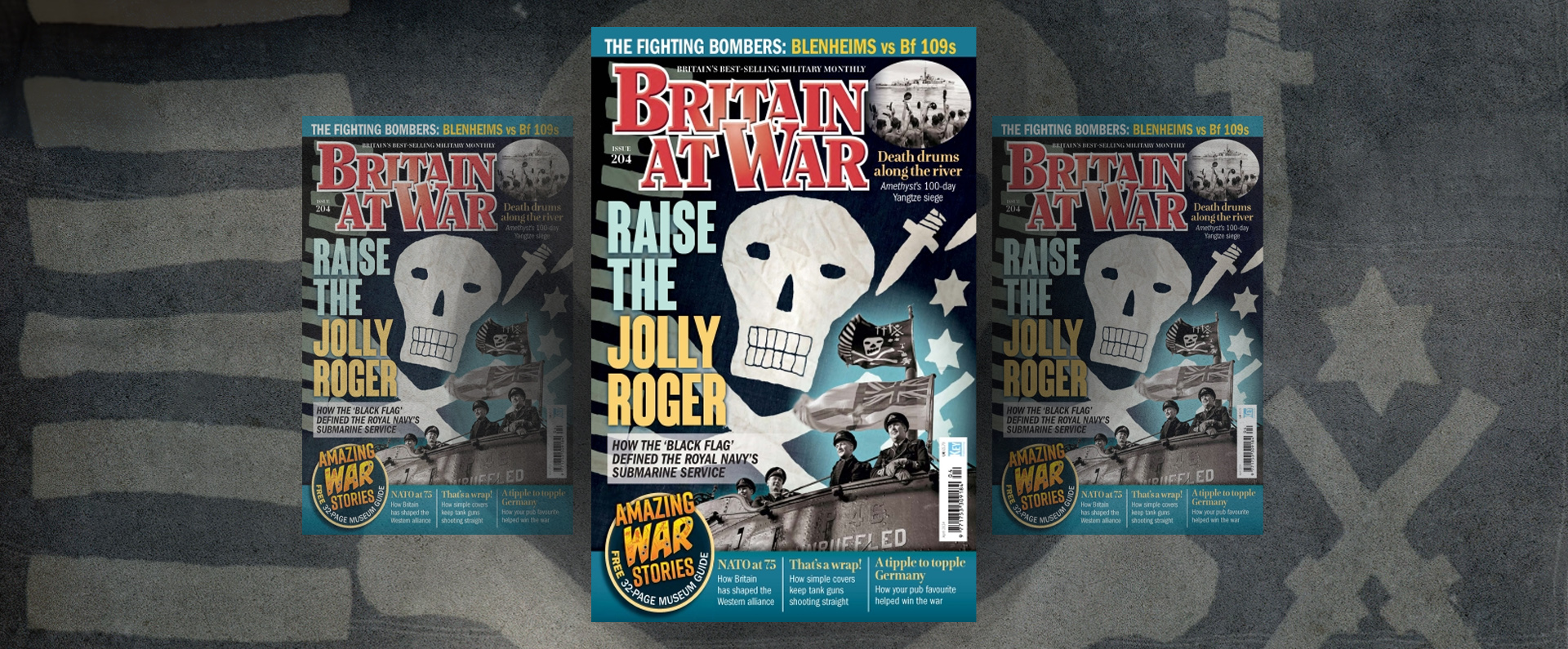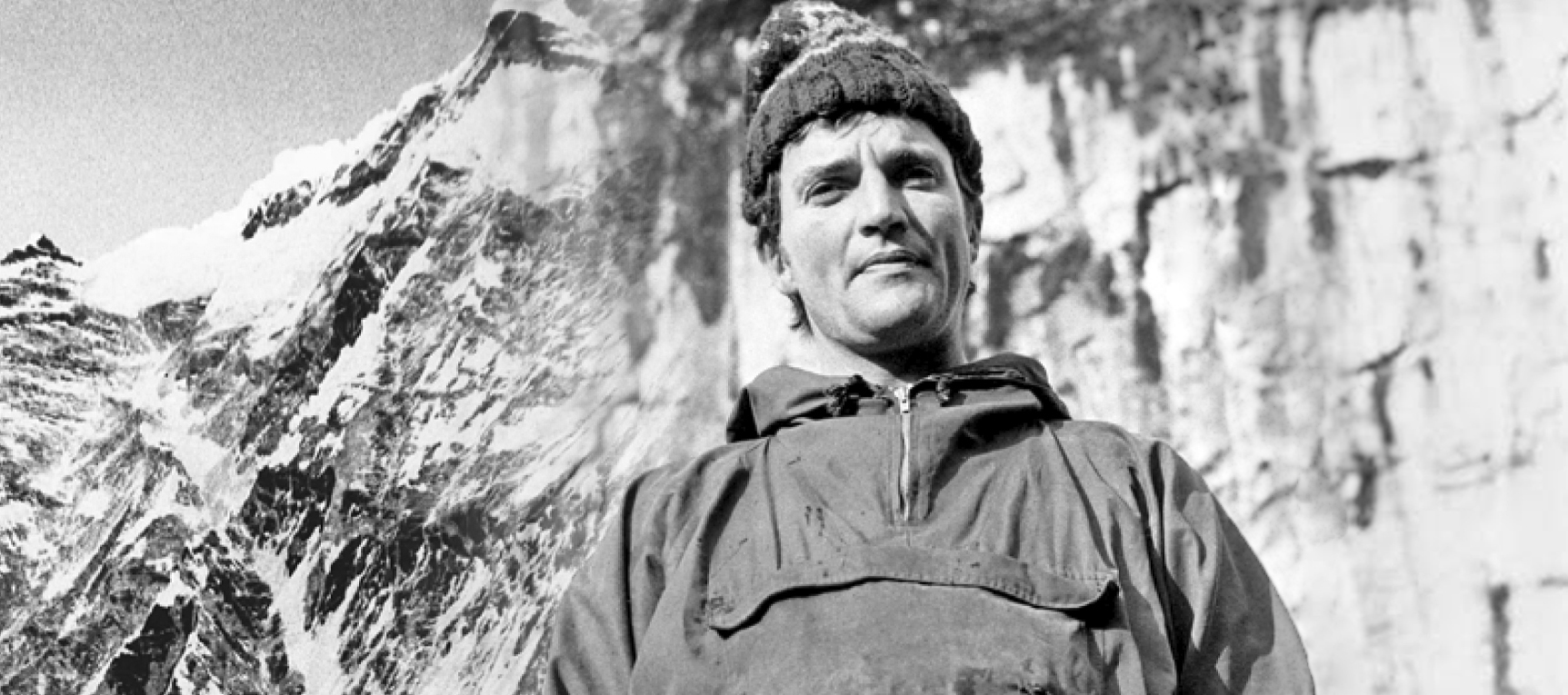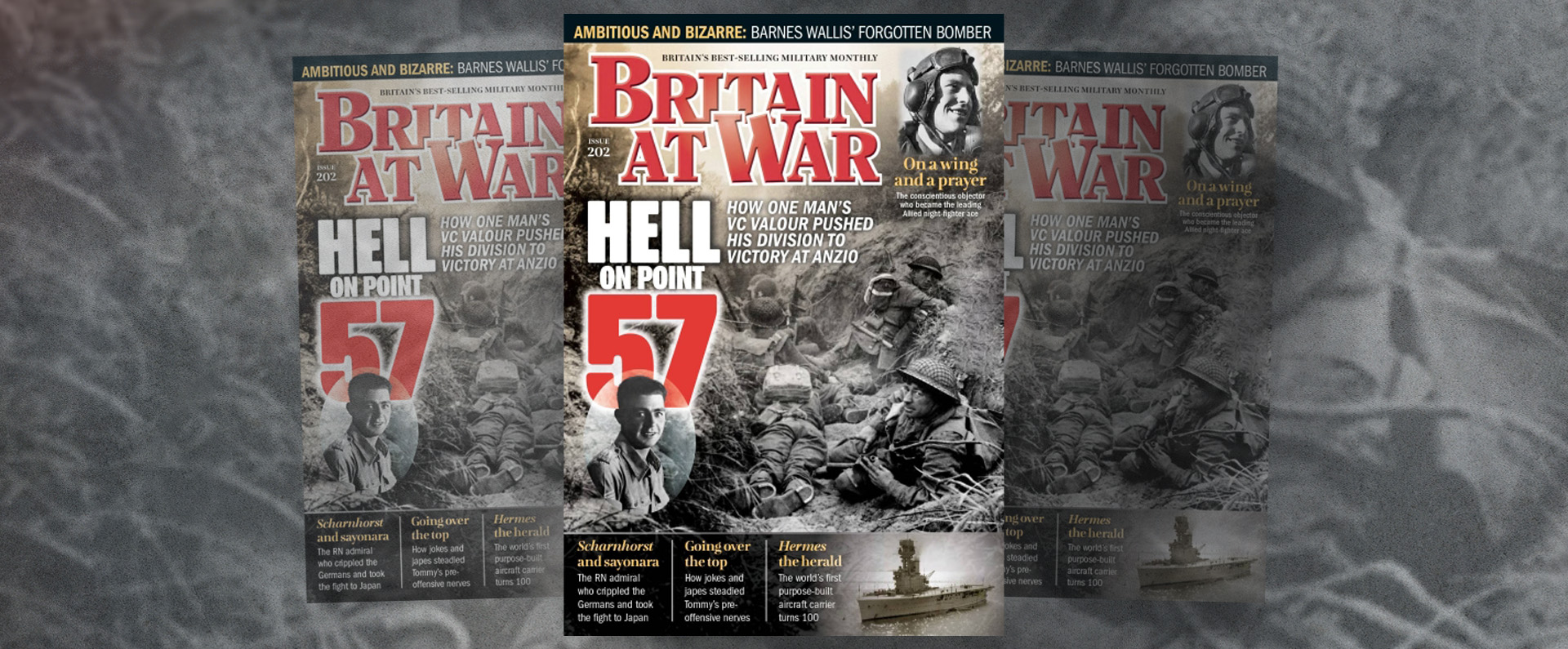
Published in Britain at War in November 2022.
Staff Sergeant Peter Herlick Rene Naya MM
Staff Sergeant Peter Naya was decorated for an outstanding act of bravery after the RFA (Royal Fleet Auxiliary) Sir Galahad was bombed and set on fire during the Falklands War. As a result of the attack on the ship in Bluff Cove, 48 men lost their lives, the biggest single loss by the British during the conflict. Had it not been for the courage of Naya and others like him, many more lives would have been lost.
Peter Herlick Rene Naya, who was known by the nickname of “Pierre”, was born in Ocean Road Hospital in Dar es Salaam, the capital of Tanzania, on July 4 1945, close to the end of the Second World War. He was one of five children born to Jules Rene and Rita Naya, who were strict but loving Catholic parents. Some 5 ft 8 ins tall, slim and handsome, Pierre was good natured, charming, musical and a strong swimmer.
In 1964, the family moved from Tanzania to Britain, travelling by ship and with different members going at different times. On June 21 1964, Naya enlisted into the Royal Army Medical Corps (RAMC), shortly before his 19th birthday. It was to be his life for the next 22 years and his younger brother, Michael, later joined him in the RAMC.
Naya was trained as an Operating Theatre Technician (OTT) and his first posting was to the military hospital in Colchester, Essex, where he remained for six years. There he met and married Nina, who was training to become an Army nurse. The couple went on to have four daughters.
After various home and foreign postings, including working in Hong Kong and Berlin, Naya was working in early 1982 at 22 Field Hospital, near Aldershot, Hampshire, training staff to operate in war zones. As the crisis grew in the South Atlantic, Naya, by this point in the rank of Sergeant, was ordered to Southampton on May 12, where he embarked on the converted luxury liner, the QE2, before heading off to war.
As they neared the Falklands, Naya and his comrades transferred to the MV Norland as it was deemed too risky to take the QE2 to the Falklands in case she was attacked. As they headed for Ajax Bay on East Falkland, the weather deteriorated, and they were caught in a fierce storm. For the last leg of their journey, Naya and his comrades from 55 Field Surgical Team moved on to Sir Galahad.
The recommendation for Naya’s Military Medal (MM) takes up the story: “On June 8 1982, whilst at anchor in Fitzroy Sound, East Falkland, RFA Sir Galahad was bombed and set on fire by enemy aircraft. Embarked troops included two companies of infantry and the main body of 16 Field Ambulance, men and equipment. At the time of the attack most of the troops were positioned in the tank deck where substantial quantities of ammunition soon began to explode as the fire worked through the ship. Over the course of some two hours 135 casualties, the majority with burns and amputations, were evacuated to the ADS [Advanced Dressing Station] already ashore at Fitzroy settlement.
“Sergeant Naya, Royal Army Medical Corps, was standing in the tank deck when he was thrown against a bulkhead by the first explosion and partially stunned. The lights went out and the tank deck began to fill with dense black smoke. A second explosion killed two men behind him, set his large pack alight and scorched the back of his head. Shrugging off the burning material, he managed to lead a third soldier by hand up two flights of stairs to daylight. There he paused to cut burning clothing from other soldiers with his scissors before mounting a third flight to the upper deck. He then helped to carry a man who had lost a leg up to the forecastle, having first dressed the stump and set up intravenous infusion. He treated many more casualties, including another amputee, and set up several more infusions, until all casualties had been evacuated; he left the ship on the last helicopter, later to be evacuated as a casualty himself. After three days only he returned to duty in the Advance Surgical Centre of the field ambulance, where he worked steadfastly through the most intense period of military activity and the passage of many battle casualties.
“Sergeant Naya, being a casualty himself, was well aware of the dangers he faced remaining in the stricken vessel and yet, with no thought for his own safety, devoted himself to the care of his injured comrades until such care was no longer required.
“Sergeant Naya’s conduct throughout showed immense personal courage, courage deserving of formal recognition. He acted in the highest tradition of the Royal Army Medical Corps.”
Long after the war, Naya provided a vivid account of the events on June 8 1982 for Max Arthur’s book Above All, Courage: Personal stories from the Falklands War: “The first inkling I had of us being attacked was this loud roaring, whooshing noise and I looked up just in time to see an aircraft zooming past; it was flying so low you could tell it was going to rocket or shell us. I instantly registered the colour was wrong. It was a dingy, browny, chocolate colour. I shouted ‘It’s not ours’ and simultaneously someone shouted ‘Hit the deck’, then bang, it struck and all hell broke loose!
“The massive orange fireball started the devastation. It burnt blokes, it killed blokes, everywhere there was the screaming of men in agony, pain, shock, fear, panic – it all happened in seconds. I was very bewildered and struggling around totally dazed. It was pitch black and I could feel this intense heat burning the back of my head – then I realized my backpack was on fire, so I pulled it off and beat out the flames. Everywhere around me was in chaos. My first thought was that we’d been wiped out. I couldn’t see a thing; all I could smell was the burning metal and flesh and this acrid smoke. It was stifling and the heat was scorching my lungs – all I wanted to do was get out from the tank deck. I knew there was a hatch behind me so I made a beeline for that. Needless to say, there must have been about 100 other people with the same idea, some of whom were in a terrible mess.
“I managed to haul myself and pull others and push others up two flights of stairs towards daylight. On the way up to the top deck I grabbed hold of this injured Guardsman – he was in agony but I knew I had to get him up on deck. He kept screaming, “Mind my leg, mind my leg,” but he’d lost his leg – it was a phantom pain. I tried to pull him up the stairs by his belt but he was too heavy for me and we both fell backwards but I somehow struggled up those stairs with him. How I got him out of there I don’t know, it must have been pure adrenalin. I’d got my arm round this poor sod and took him to the bow of the ship to evade the smoke. All the time I was carrying him his bone was hitting the deck and leaving a trail of blood.
“It was chaos everywhere on deck. Smoke and flames were billowing up from below, ammunition was going off, and there were blokes running around screaming because their plastic all-weather gear had caught fire and was sticking to them, burning their skin away – it was pitiful to watch them trying to tear it off. That was an awful sight – such pain, such terrible pain. I’d never seen anything like it. They [the injured] were just rolling about on the decks…
“I didn’t have time to think. If they’d attacked us again I wouldn’t have known it because there was so much smoke and confusion – it was horrendous. I couldn’t see any doctors working (I found out later they’d been taken off before the bomb struck) and I couldn’t see any medics working: I thought I was probably the last medic alive. So I thought, ‘Come on, Pierre, you’re the only medic, get to it.’ So I got stuck in with what medical kit I had – a pair of scissors! The rest had been blown to pieces – wiped out.
“So I got to my knees and started to cut away at some of the badly burnt clothes to expose the wounds. I became a focus for people – they knew at least someone was there to help. The NCOs were marvellous, keeping everyone calm and bringing the injured men up to me and talking to them while they waited. I began smashing up crates of wood to make splints because there was nothing else. The Welsh Guards who’d survived came by and dropped their field dressings for me; others gave me their intravenous drips or held someone while I got at his injuries. Everyone rallied round – they’d got over the initial shock and were doing all they could to help me…
“I don’t know how I kept a sober head on me at the time. All I remember was fixing guys, trying to put a figure-of-eight bandage round some poor bugger’s legs that were smashed, then kicking a pallet to pieces trying to get splints from it – it was all so primitive. I was putting the field dressings over this fellow’s stumps, I then grabbed someone’s webbing straps to use as a tourniquet on what was left of his leg and used a guy’s bayonet to tighten it. Then I looked up at the poor devil and saw his face was swollen to twice its size, like a pumpkin, and was completely black with the flash burn.”
After spending between an hour and two hours tending the wounded, Naya was eventually rescued from the ship by helicopter. He remained working in the war zone until the Argentine surrender, and then stayed for a further two weeks before eventually returning home. “I feel humble, and lucky, that I survived….I certainly don’t consider myself a hero. I just did my job,” he said.
Naya attended his investiture at Buckingham Palace on February 8 1983, accompanied by his wife and his mother. He was discharged from the Army in the rank of Staff Sergeant on June 20 1986, after 22 years’ service.
Next, he worked in a management role for the NHS before enjoying his retirement with his wife on Portugal’s Algarve. Eventually, however, Naya’s health deteriorated. After a triple heart bypass operation in Lisbon, he initially seemed to recover well – only to die suddenly in his wife’s arms on October 6 2012, aged 67. At his funeral in Praia la Ruiz, on the outskirts of Lagos, his coffin was draped with an RAMC flag. Today I feel proud and humble to be the custodian of his medal group.
Download a PDF of the original Britain At War article.
For more information, visit:
LordAshcroftOnBravery.com


